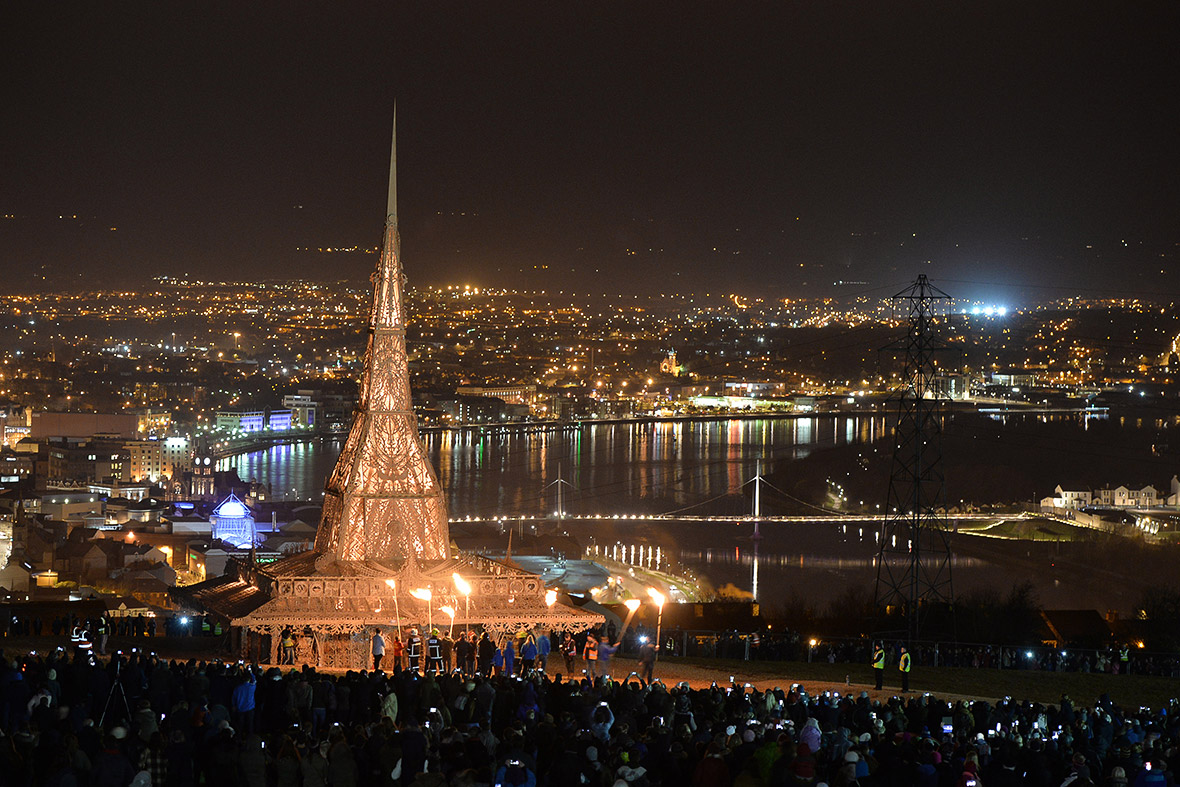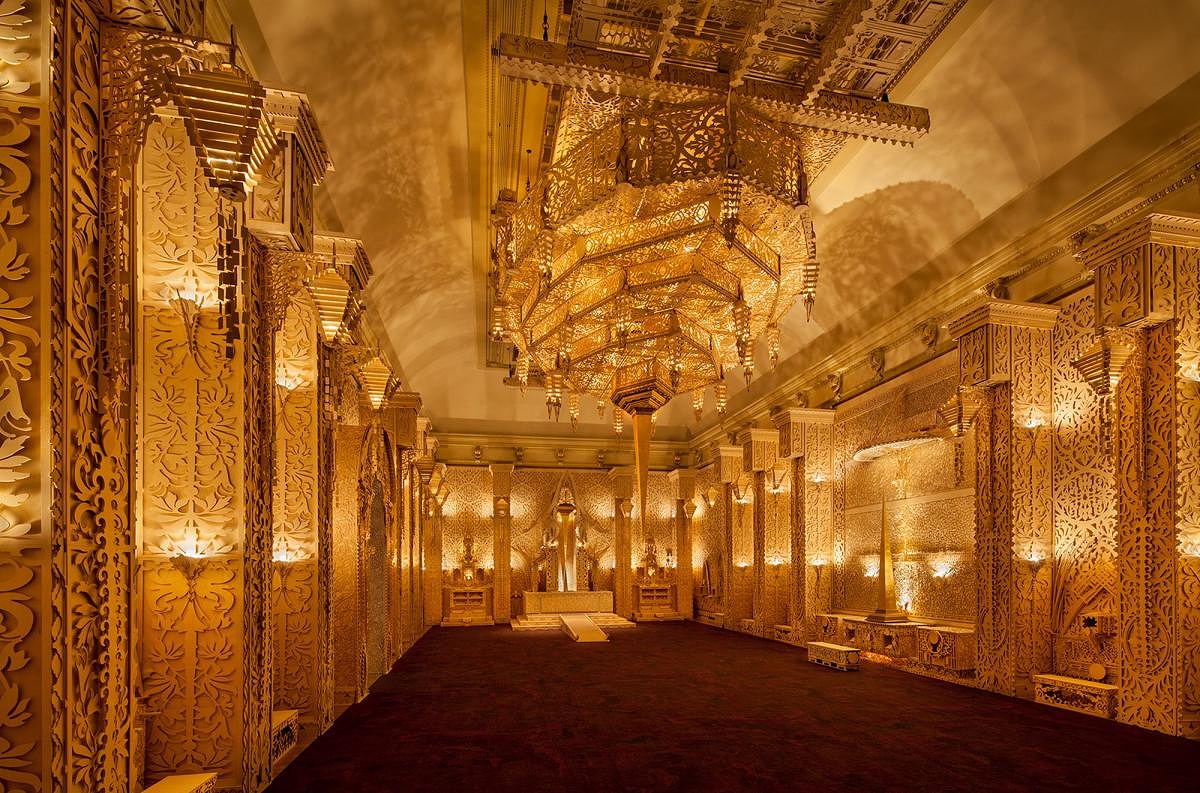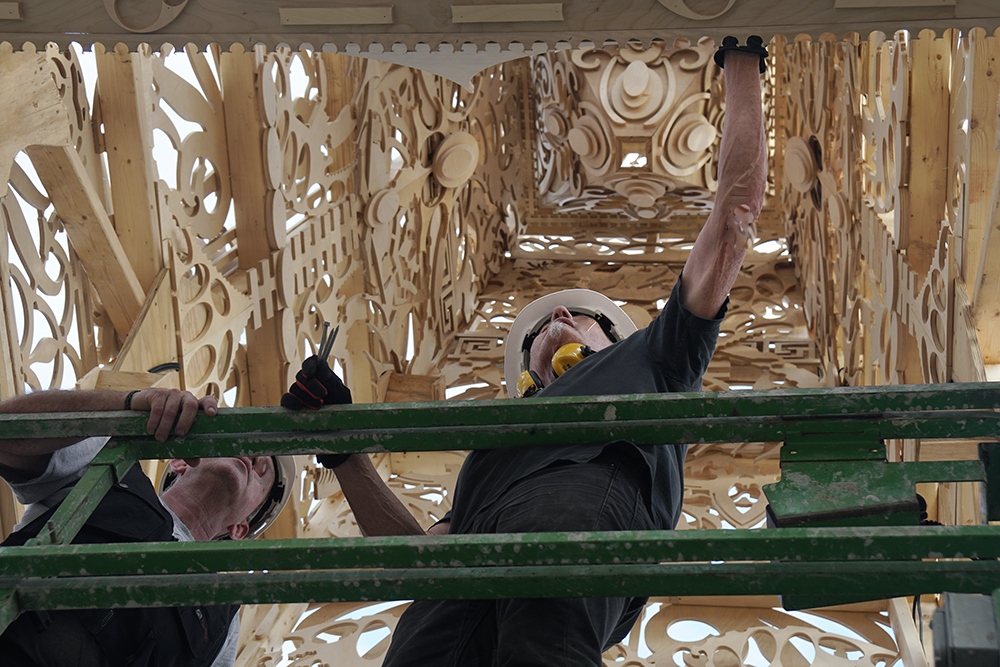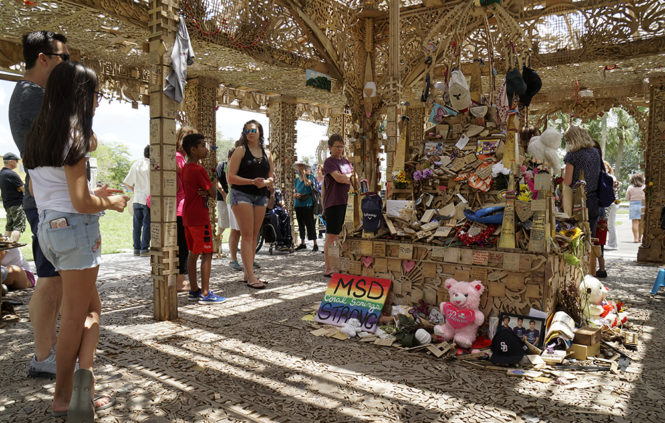David Best is known internationally as the builder of impermanent, non-denominational temples. He was born in San Francisco in 1945. He took art lessons at the age of six at the San Francisco Art Institute. He later earned a BFA at the College of Marin and an MFA in sculpture at the San Francisco Art Institute. He created art from found and recycled materials. His work is committed to public art in public spaces, open to everyone to experience.
Best and his crew went to Burning Man in the Black Rock Desert in Nevada for the first time in the summer of 2000. Using recycled cardboard panels, perforated wood strips, and other recycled materials, they constructed “Temple of Mind.” On the way to Burning Man, one of their crew members was killed in a motorcycle accident. They dedicated the structure him, and it immediately became a place of meditation and remembrance. It was a place to heal and to express deep emotions. The Burning Man community embraced this non-denominational temple. They brought mementos and left heart-felt messages on the walls. One of the tenets of Burning Man is to leave the location in pristine condition. A tradition at Burning Man is to set the figure of a man on fire on the last Saturday night of the festival. On Sunday night, the last night of the festival, the temple was burned. A tradition was started.
Best and the crew returned the next year and constructed “Temple of Tears” (2001), followed by “Temple of Joy” (2002), “Temple of Honor” (2003), “Temple of Stars” (2004), and “Temple of Forgiveness” (2007). The tradition continues at Burning Man, and Best and others have taken up the challenge of creating a unique temple for the community each year. Best describes the purpose of the temples: “For people to feel safe, to feel and express deep emotion and so they can heal, the temples must be beautiful and delicate while at the same time being strong to provide comforting support.”

Derry/Londonderry, Ireland (2015)
Best and his crew also have constructed temples by request from international groups. The Artichoke group in the United Kingdom, whose purpose is to work with artists to hold events in public spaces, asked Best to construct a temple in 2013. Best had a house in southern Ireland and was familiar with the conflict between Catholics and Protestants. Derry/Londonderry, Ireland (2015) was seventy feet tall. Best commented “You have to tread very lightly. There are two sides to that: one is that it’s somebody else’s culture and somebody else’s country; the other is that it’s all one. We are here on Earth just as visitors. You have to be very humble and very quiet. Best continues, “One of the things I want to emphasize is that I’m not coming to Derry-Londonderry to try to change their tradition of the Protestants’ fire and the Catholics’ fire. I’m just offering an additional option where they can build a fire together.” Protestants and Catholics did come together in the temple. They left photos, letters, and mementos, and they also left their weapons.

“Temple” (2018)
After the renovation of the Renwick Gallery in Washington, D.C., was finished in 2018, the Gallery organized the exhibition “No Spectators: the Art of Burning Man.” Best created “Temple” inside one of the museum’s spacious galleries. As the title of the exhibition states, visitors were not to be just spectators but were encouraged to participate, and they did. The following message was displayed: “This temple is a sacred place for memorial and reflection. It’s intended to bring healing to the world, and it was built by many hands, all who have lost something. Many places exist for celebration, but few places are created to honor the universal human experience of grieving and loss. This is such a place.” Gallery visitors covered the interior of the structure with messages on wood blocks and messages on the walls. It was inspiring, memorable, and cathartic, even though the temple was not burned.

“Temple of Time” (2019)
“Temple of Time” (2019) (35’ tall) was opened on February 14, 2019, on the one-year anniversary of the massacre of 17 victims at the Margery Stoneman Douglas High School in Parkland, Florida. The temple was set on fire on May 19, 2019. Best chose the title “because only time would heal such grief.” Best and his crew were sensitive to the situation, and they selected workers from the community to help with the build: “Work is healing. That is what we offer to a handful of people: the option to work, and working, they started to find the healing process, and by the end more than 600 people participated. So, working with families and friends who lost someone dear to them, they begin to be able to have forward motion.”
Best thought he would be working with 17 families who had lost someone in the massacre, but he discovered families of the wounded, firefighters, first responders, and community members also suffered.

“Temple of Time” (detail)
Each temple Best and Crew have built is different; however, all were intricate structures. Layer upon layer of elaborately cut wood designs covered the walls, while creating another pattern of holes for light.

“Temple of Time” (detail)
“Temple of Time” was part of a larger project Inspiring Community Healing after Gun Violence: The Power of Art. Among the 600 participants were a group of young adults from a community group in Coral Springs, Florida, that provides training, employment, and housing for young autistic, intellectually, and developmentally disabled persons.

Temple of Time” (detail of burn)
The families of three victims were selected to burn the Temple on May 19, 2019. Best wrote in his journal, “What we all understood was that we had a chance to be a part of something precious and profound—that there is no perfect way to address the pain, and that only time will tell what we provided.” Proposed national gun legislation has not been passed by the U.S. Congress.

“Sanctuary” (May 21-28, 2022)
“Sanctuary” (May 21-28, 2022) (65’ tall) was built in Coventry, England, to commemorate the nation’s loss during Covid. The temple was constructed in the Miners’ Welfare Park in Nuneaton and Bedworth. More than 195,000 died of Covid. The hilltop location was chosen so the temple could be seen from a distance. Over 400 people from the community and the schools participated in the build. Best stated: “This past year and a half has not been easy for anyone. We have faced terrible tragedy and great loss. I believe in the power of collaboration and community, that by recognizing pain and sadness, and laying down our burden, we can face the future from a place of hope and renewal. That is what I hope Sanctuary will bring to the people of Nuneaton & Bedworth, West Midlands, and everyone who makes the journey here.”
Among the seven torchbearers selected to set the fire to the temple was the Very Reverend John Whitcombe, Dean of Coventry Cathedral. Helen Marriage, artistic director of Artichoke observed, “The thousands of visitors who have streamed into the memorial and left messages and the thousands more who came to watch it burn have shown how necessary it was.”
“The world is going to need temples. They won’t burn anymore, we can’t burn them. We’ll build them out of materials that can decompose and turn them into gardens, community farms, and parks for children and families.” (David Best)



Darrell parsons says
Thank you for this. I hadn’t heard of it